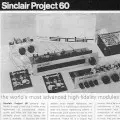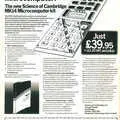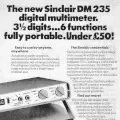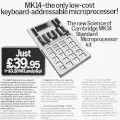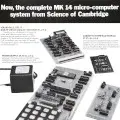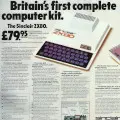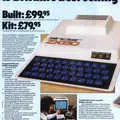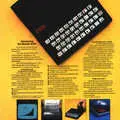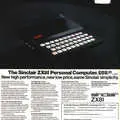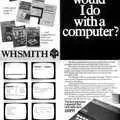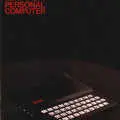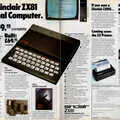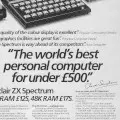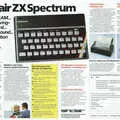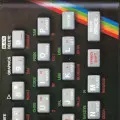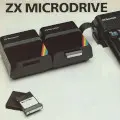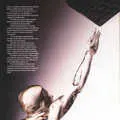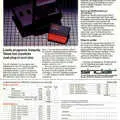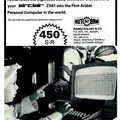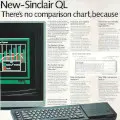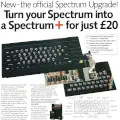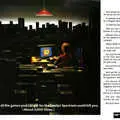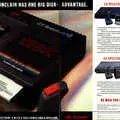
Sinclair Advert - March 1983
From Personal Computer World
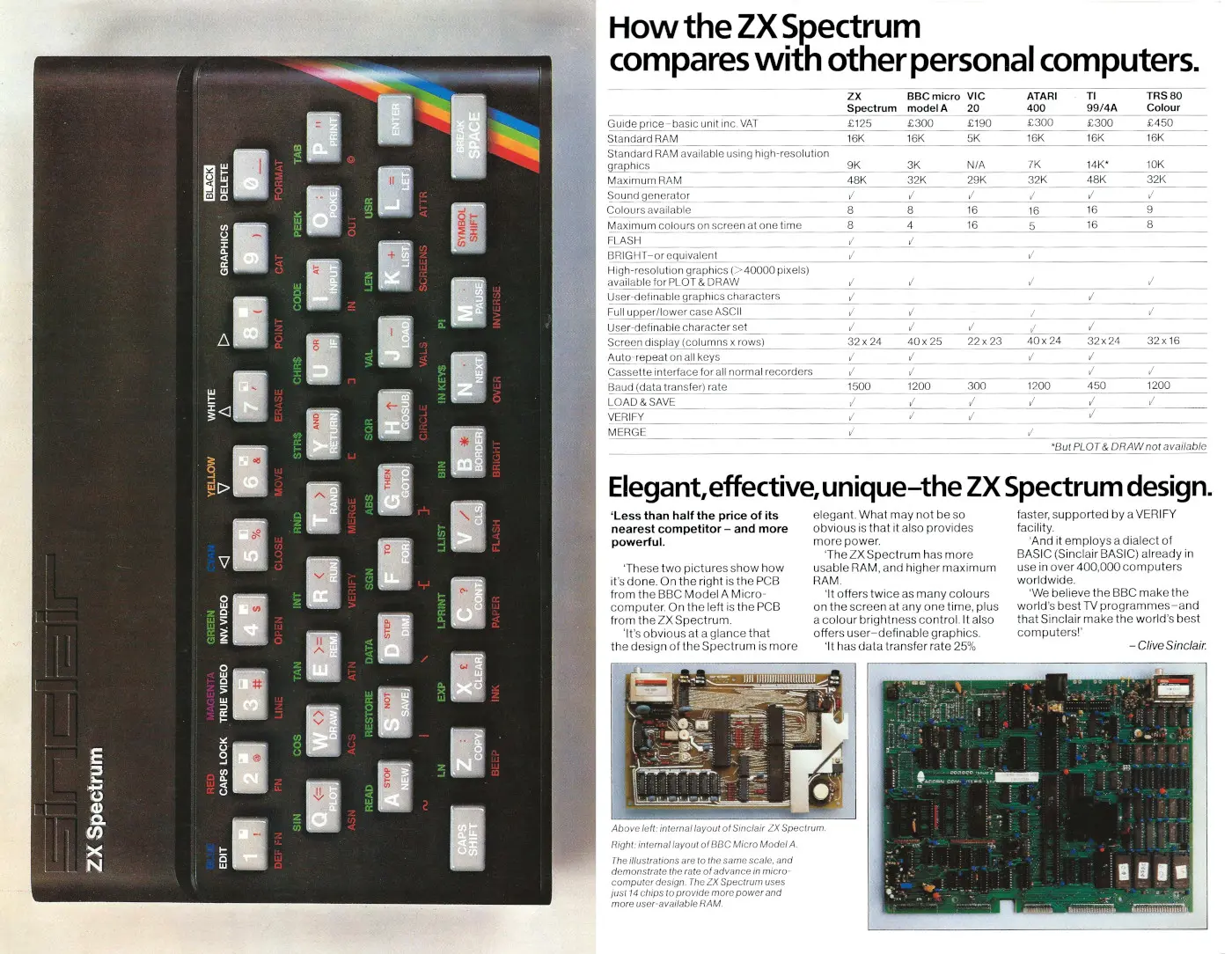
ZX Spectrum - 16K or 48K RAM from only £125!
This advert is part of an impressive four-page spread that appeared early in 1983 for the Sinclair Spectrum, launched at the end of April 1982 but which took eight weeks until first deliveries actually appeared around June 1982.
High demand, problems gearing up production and a circuit fault were blamed for causing the delay.[1].
The Speccy is often credited with being the machine that really launched the UK IT industry and, in its various forms, went on to sell around five million units.
However the Sinclair company itself struggled beyond the mid-1980s, selling its name to Amstrad in 1986.
In common with its predecessors, the Spectrum was a Zilog Z80 machine. It came with 16K or 48K RAM and improved on the ZX80 and ZX81 by having a moving keyboard. Even though this was rubber, it was better than the membrane keyboard of the earlier models.
The advert reveals that Sinclair had finally moved order handling from its offices in Kings Parade in the heart of Cambridge to the suburban commuter-belt of Camberley in Surrey, where its sometime ZX80 and ZX81 distributor GSI was based.
By the end of 1983, GSI was doing so well out of Spectrum mail-order distribution that it had to expand to nearby Frimley, having gone from 500 ZX80's a week in 1980 to 20,000 Spectrums.
It was also gearing up for Sinclair's flat-screen TV as well as the upcoming "professional computer", aka QL[2].
School Approved
By September 1982, the Spectrum had been grudglingly approved by the Department of Industry for use in schools, thanks to some intervention from Sinclair's own Nigel Searle.
Now Sinclair was a potential beneficiary of a £9 million (about £43 million in 2025) government spending spree, even though "Uncle Clive" was said to have been disliked by Whitehall mandarins, perhaps because his Sinclair Radionics company had been part-nationalised at public expense.
At this point, Kenneth Baker's Information Technology Ministry liked to quote that there was "at least one micro in every secondary school in Britain", with the increased spending intended to fill in the gaps in a further 27,000 primary schools.
The Speccy would have been up against the Model "B" BBC Micro (Acorn Proton), with disk interface, or Research Machine's 480Z for £818 (about £3,920 in 2025).
The Sinclair, complete with compulsory colour monitor in order to make it significantly less competitive than the other choices available, sold for £472 (£2,260), despite the fact that a colour monitor would have been mostly wasted as the Spectrum "had its output bandwidth restricted to prevent PAL dot-crawl"[3] - a kind of chequered rainbow interference between blocks of colour.
Delay repay
A month later, in October 1982's issue of Personal Computer World, Clive Sinclair published a letter apologising for delays in getting Spectrum orders fulfilled, in which he explained why many customers would have to wait up to 12 weeks.
The reasons including being "swamped with orders", compounded with some "small initial production delays".
By some way of compensation, users who waited out were offered a £10 voucher towards the £59.95 (£280 in 2025) ZX Printer or a 5-pack of printer paper, which normally retailed at £11.95 (£57) - both of which also feature in this advert.
The ZX Printer was formally discontinued in May 1984, following declining sales since the release of the Sinclair Interface 1 - a plug-in module which allowed owners to attach real printers to their Spectrum.
The thermal printer, which used special aluminised paper, had sold several hundred thousand since its release in 1981. As a result, the paper would continue to be manufactured in limitied quantities for some time[4].
Sinclair closed his letter by saying "Production is [now] running smoothly at 5,000 units per week and will rise sharply over the coming months"[5].
Nigel Searle of Sinclair explained the delays in an interview with Popular Computing Weekly, where he said:
"the scary thing about it was not simply that we weren't producing enough machines, but that we didn't seem to be able to control the numbers we produced even with relatively small numbers. We have not been able to predict with confidence how many we could produce in a week. On a day when we might have hoped to make 400 Spectrums, we might have made only 40. The RAM expansion unit was the main problem and we are only now getting back to the sort of production levels we were at before Timex went on its three-week holiday in July".
Re-wiring the Spectrum
In a nod to the controversy surrounding Sinclair's hoarding of the up-front payments for Spectrum orders - and the interest it was earning - Searle continued:
"I accept our mistake in having a product that could not be reliably produced. It may not seem so, but we have spent an absolute fortune in customer service in the last few months - far, far more, I can assure you, than any interest accruing from the money orders we have received"[6].
It had only just been disclosed that Sinclair had actually redesigned the Spectrum's printed circuit board, in order to reduce some of its production difficulties, even though it hadn't actually told anyone.
This included the large number of companies which had grown up around first the ZX80 and 81 and now the Spectrum, some of which, like DK'Tronics and Downsway, were now finding that their 32K expansion packs were no longer compatible[7].
DK'Tronics said of the change that "The new board has caused a few hiccups here - because we weren't at first aware of it - but we shall just change our design", a move which meant that DK and the others now had to produce two versions of each of their expansion boards[8].
Sinclair had already had to change its circuit board after a design flaw had been discovered in the first batch of Spectrums to roll off the production line.
The batch of machines, which had been returned to manufacturer Timex for the fix, had to have a couple of circuit board tracks cut by hand and then have a NAND gate soldered on between the board and Spectrum's Uncommitted Logic Array chip.
The fix was swiftly integrated into the production line in time for the release of the second batch of machines, which rolled out of Timex's Dundee factory during the last week of June 1982[9].
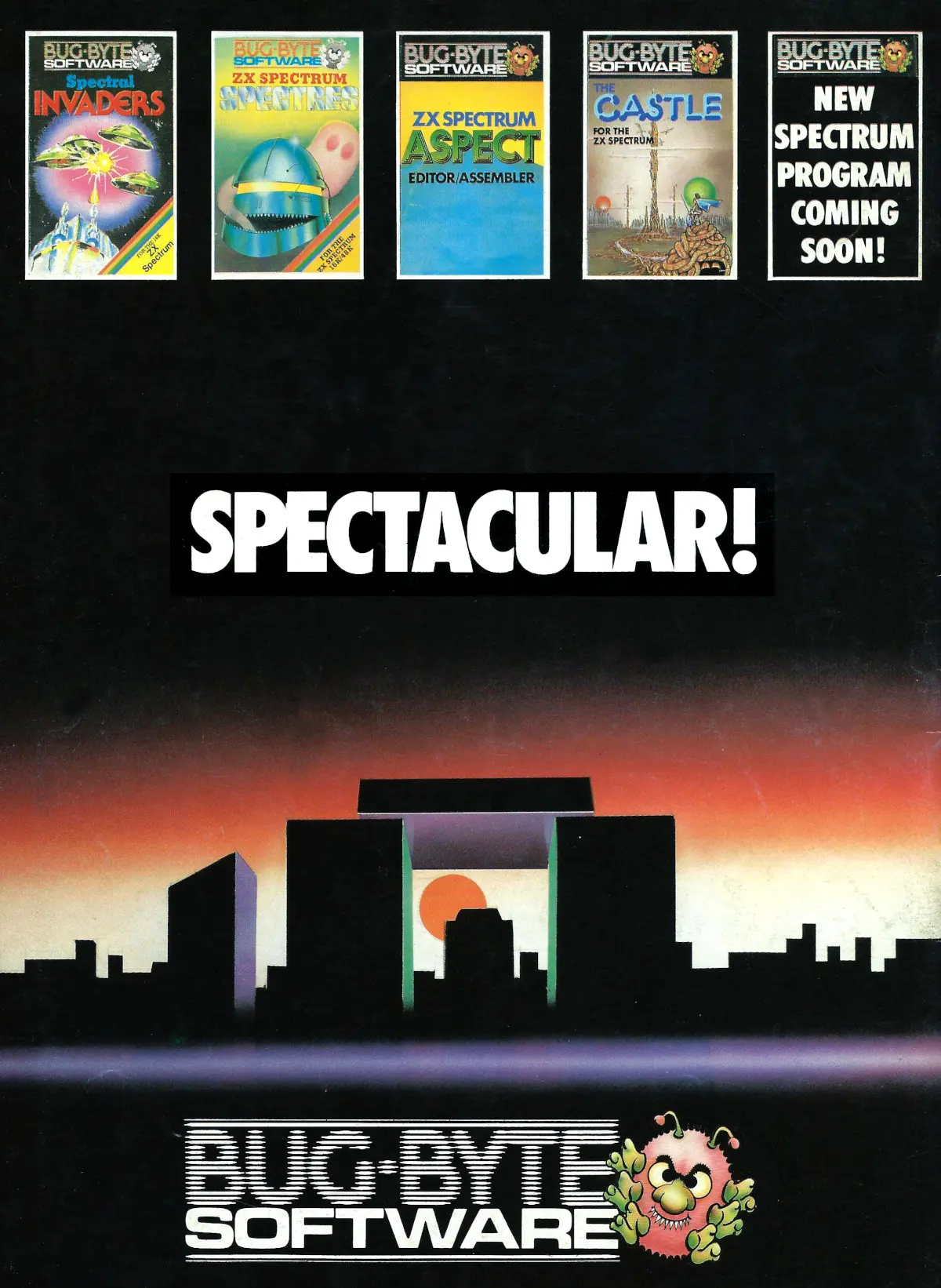
Bug-Byte's Spectrum software, including the not-a-clone-of-space-invaders Spectral Invaders. From Personal Computer News, April 15th 1983
At the same time, the first commercial software for the Spectrum appeared, thanks to AVC Software's "Fortune" and Bug-Byte's clone of Space Invaders - imaginitively named in a way that was totally unlike the original and which was sure to deflect any chance of legal action - "Spectral Invaders"[10].
The market explodes
The existence of companies such as DK'Tronics was one of the most significant things about Sinclair's impact, which was not just that it had turned computers from being some sort of hi-tech "big brother" into something "personal", but that it really turned the market on its head.
Microcomputers had gone from expensive machines aimed at hobbyists and nerds to mass-market electronics aimed at general consumers, a change which led to the UK in 1983 having the highest per-capital ownership of computers anywhere in the world.
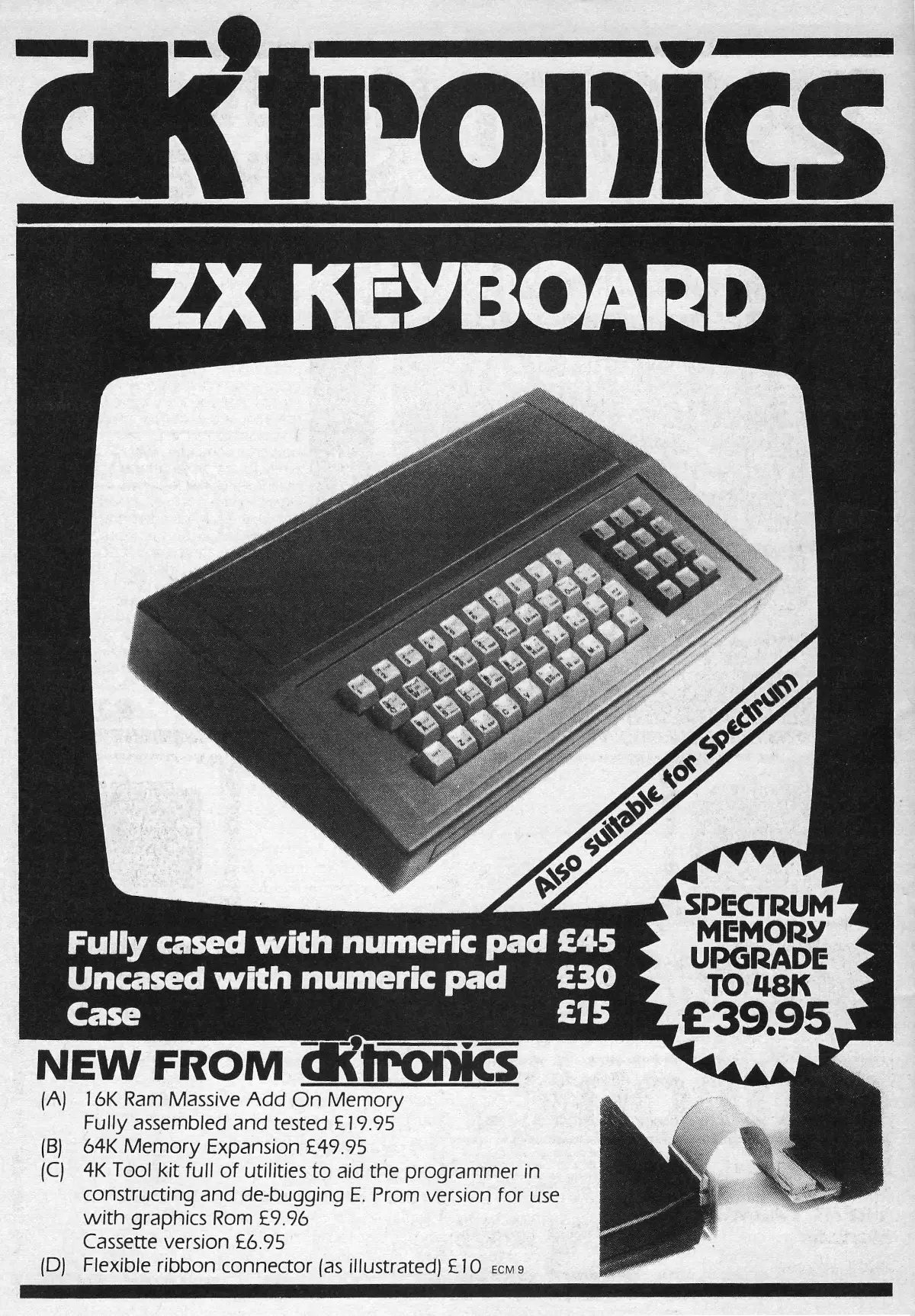
DK'tronics and its real keyboard for the ZX81 or Spectrum. The full case with numeric keypad retailed for £45, or about £160 in 2025. From Electronics and Computing Monthly, September 1982
This helped spawn an entire infrastructure of peripheral manufacturers, suppliers, software companies and even magazines. Tim Hartnell, one-time editor of ZX Computing reckoned that in the twelve months following the launch of the ZX81, a new Sinclair-related business was created every 36 hours.
Before the ZX80, there were thought to be 40,000 computers, from all manufacturers, in the UK. Sinclair added an additional 50,000 ZX80's in that machine's first year of production, before going on to add an extra 300,000 micros by the end of 1981 and two million by the autumn of 1983[11]. That's an expansion of two orders of magnitude in the space of less than four years.
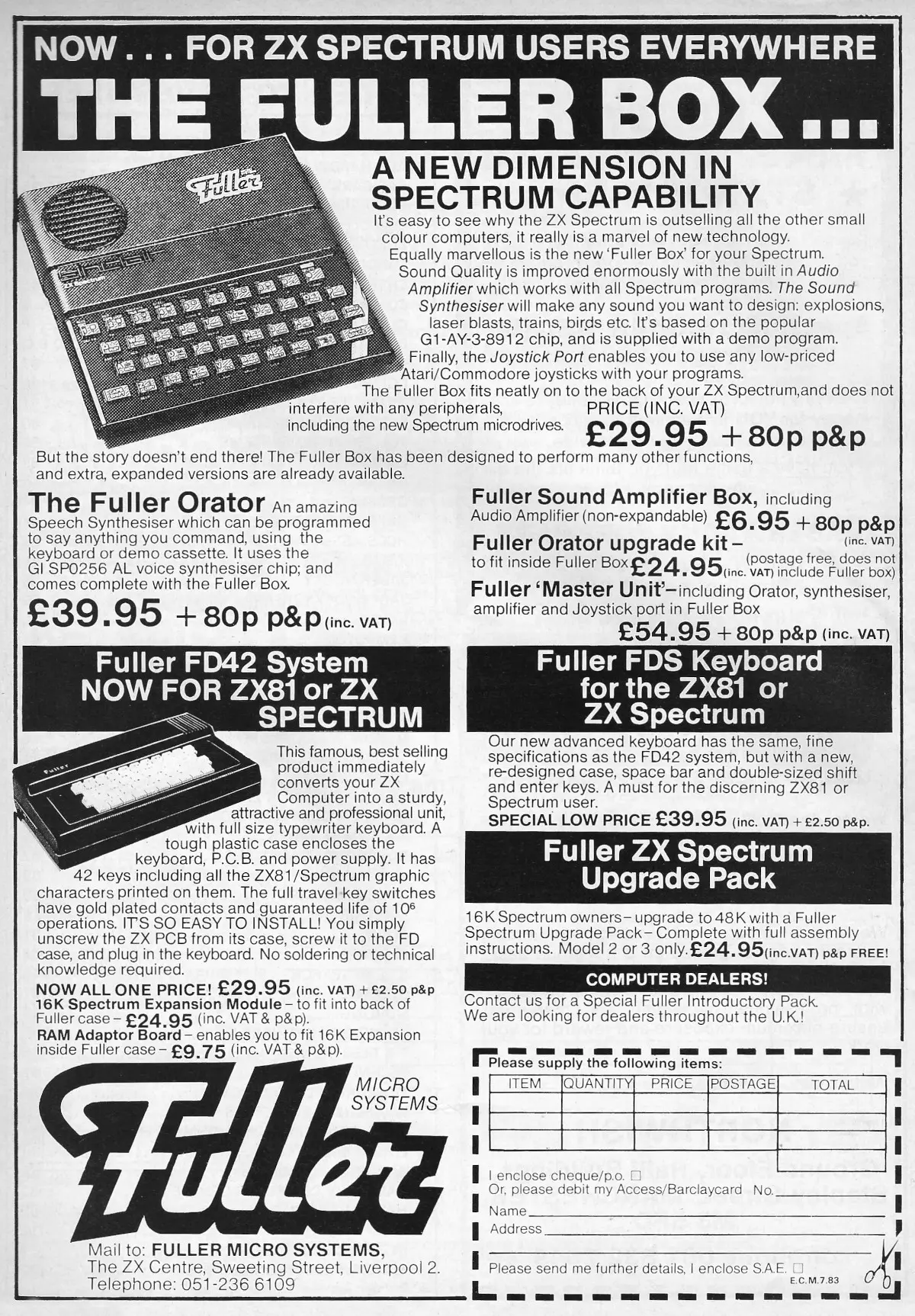
Fuller was another of the many ZX81/Spectrum third-party companies, in this case producing a novel speaker attachment for the Speccy, as well as a proper keyboard for either machine. From Electronics and Computing Monthly, July 1983
Meanwhile, there were some more production-related problems early in 1983 as Sinclair found itself having to recall Spectrum power supplies after it was discovered that "up to 14,000" of them could cause electric shocks.
That figure was later updated to 28,000 by Your Computer, which also revealed that the fault was down to the 240V input track on the power pack's circuit board running far too close to the 6V output.
This meant that a power spike in very humid weather could result in a shock.
Sinclair's MD, Nigel Searle, admitted that the supplies - just one batch from one supplier - "were not checked in detail for safety".
Unlike any other of Sinclair's mail-order activities, the duration of which was normally measured in months, Sinclair was at least managing a turn-around of a mere 48 hours to replace the defective units[12][13].
Earlier in 1982, Uncle Clive had met with Prime Minister Thatcher and, as a result, found his ZX Spectrum selected as an example of "recent British high technology" and presented to Japanese premier Zenko Suzuki during Thatcher's official visit to Japan in September.
Three custom Spectrums, with adaptations for Japan's 60Hz NTSC standard television standard, had been built and presented, with Premier Suzuki being apparently delighted with his rubber-keyed 8-bit gift.
Helping Thatcher run a short demonstration program showing the flags of GB and Japan was Sinclair's John Mathieson, who had been given two days' notice of the trip.
He said "Clive telephoned me and said they wanted somebody to demonstrate the system. I said 'where, Downing Street?'. He said 'No, Tokyo'"[14].
At about the same time, the ZX81 was launched in Austria, with distributor Electronova's Dr. Lagler hoping for sales up to Christmas in the 5,000 to 10,000 range.
Austria marked the latest European territory to be taken on by Sinclair, with the machine already selling in Spain, Italy, Denmark, Belgium, Holland, Switzerland, Norway and Sweden, as well as France and West Germany, which had sold about 50,000 '81s each[15].
Back to school
This period was clearly one of intense activity as less than one month after Sir Clive's delay-apology letter, in November 1982, Sinclair announced its own £15 million (nearly £71 million in 2025 terms) scheme to extend the "Micros in Primaries" project announced previously, as another attempt to get more Spectrums in to schools, and presumably thwart Acorn's BBC Micro in the process.
Sinclair's offer involved a free ZX Printer, a free copy of Logo and ten discount vouchers against further orders of 48K Spectrums.
Sinclair was also working on making the programming language Prolog available and expanding its own range of educational software.
To coordinate this effort, the company appointed former employee David Park, who had previously worked for the company from 1969-1979[16], and former primary school headmaster John Wright as educational consultant[17].
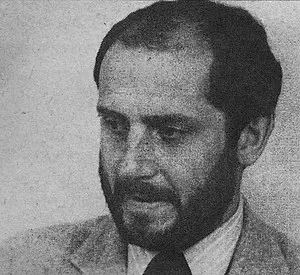
Sinclair's Nigel Searle, © Popular Computing Weekly September 1983The Spectrum was often referred to before its launch as the ZX82. It was designed by Richard Altwasser, who had joined Sinclair during the end of the ZX81 project, where he contributed the design of the 81's printed circuit board.
He mentioned in an interview with Your Computer, published in July 1982, that the name change was made for a number of reasons:
"Firstly, the ZX81 replaced the ZX80 and the Spectrum is meant to run alongside the ZX81 rather than replace it. Secondly, calling the Spectrum a ZX82 creates the impression that the company will be producing a ZX83 in the spring of 1983"[18].
Despite this, the Sinclair QL was unavoidably and widely known as the ZX83[19], and the Pandora portable project was at one point known as the ZX84.
Indeed, by 1983, Sinclair's managing director Nigel Searle had implicitly conceded that this was unavoidable, saying (of the rumoured ZX83) "It is fairly natural if you follow the sequence: ZX80, ZX81, Spectrum - alias ZX82"[20].
Altwasser (with Sinclair Colleague Steve Vickers) went on to launch the Jupiter Cantab "ACE". The day after he left Sinclair, the company posted a job advert stating "Quite simply, we are looking for the world's best computer designer".
Sinclair nails it in the UK
The Spectrum was known as the Timex 2000 when it was launched in the US (the American Timex company produced Sinclair's computers in a factory in Dundee). It had air vents, a different ROM, three-voice sound, two joysticks and there was also a more rugged printer available for it[21].
Unfortunately, Timex spent so long messing around with the spec and the case that it had missed the boat by the time its version launched, and it sold very few.
The story was very different in the UK, where in February 1983 Sinclair announced that it had sold 200,000 Spectrums in the nine months since the machine had launched, and was expecting to be shifting between 12,000 and 15,000 Speccies per week by Easter, according to current products division managing director Nigel Searle[22].
At its financial year-end on March 31st 1983, Sinclair posted pre-tax profits of £14 million for the year (£61 million in 2025), despite the fierce price-cutting raging in the market at the time, and in contrast to Grundy and Dragon Data, both of which were in serious trouble.
Sinclair's profits were derived from £54.5 million turnover - double that of the previous year[23].
Sir Clive said in the annual report accompanying the figures, published in September, that "the strong position in the personal computer market is due to [Sinclair's] technical and marketing leadership" and that "there remains much scope for innovation in the field and I believe we will continue to lead the world with future products"[24].
A few months later in August, Sinclair also announced that it had now sold half a million Spectrums in the UK and Europe, giving an average output of 6,500 a week.
This made the ZX Spectrum more successful than the ZX81, which sold 400,000 units in the equivalent 16-month period since launch.
Sinclair's MD Nigel Searle said "Of course we are delighted. And we hope that peripherals like the ZX Microdrive and the ROM cartridge we aim to publish in the autumn will keep that user group challenged by their Spectrums"[25].
It was however the beginning of the end for the venerable ZX81 as major High Street reseller WH Smith announced in July that it was to stop taking any new software titles for the machine, saying "The reason is simply that consumer demand for the ZX81 has lessened. [It] has been around for a long time and the Spectrum machine offers many more facilities".
The newsagents-cum-microcomputer seller did however offer an olive branch to Sinclair as it was to continue selling the ZX81 itself for the foreseeable future, saying "We cannot forecast what future demand for the machine will be, but at present we will continue to sell it and support it with our main lines of software".
Sinclair itself was not commenting on whether it knew about the Smiths move, but a spokesman did confirm that no ZX81 orders - hardware or software - had been received from Smiths for "at least a couple of months", before conceding that "There has been a drop in ZX81 sales over the last six months and the price drop from £49.95 to £39.95 was designed to keep the machine going".
Although it was not selling anything like as many units as the Spectrum it was, apparently, "enough to justify remaining in production".
Prism, Sinclair's major distributor, seemed a little non-plussed as it had recently introduced some new '81 titles and reckoned that the ZX81 software market was still "bouyant", although it acknowledged that hardware sales had "slackened off considerably".
Prism's MD Bob Denton concluded that "WH Smith [has] been doing some very strange things with the ZX81 recently", before suggesting that "by October we will find some product shortages"[26].
Date created: 01 July 2012
Last updated: 11 December 2024
Hint: use left and right cursor keys to navigate between adverts.
Sources
Text and otherwise-uncredited photos © nosher.net 2025. Dollar/GBP conversions, where used, assume $1.50 to £1. "Now" prices are calculated dynamically using average RPI per year.
